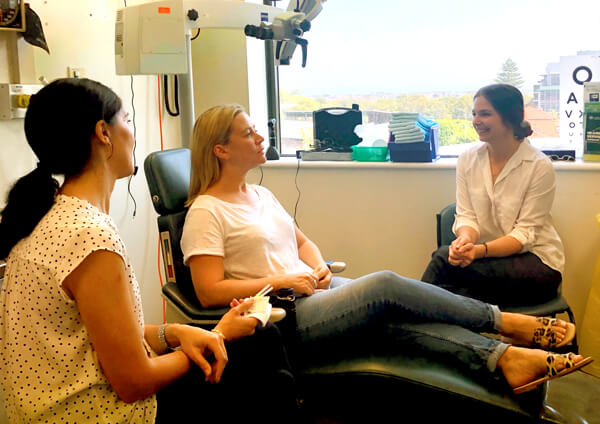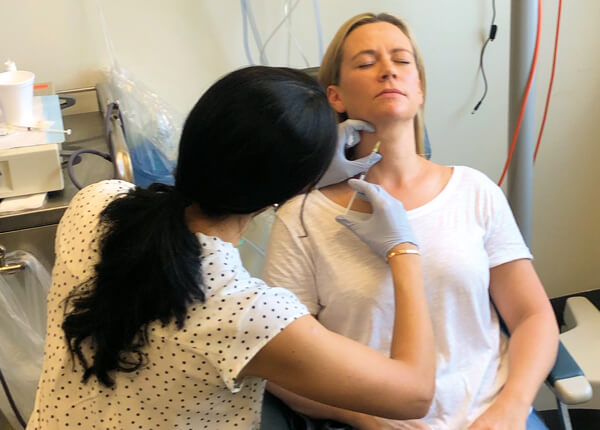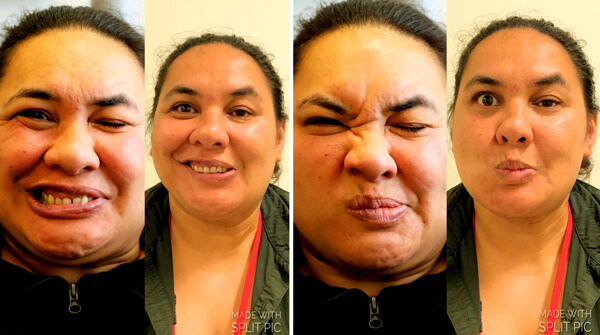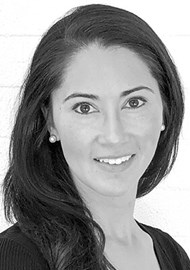Facial nerve palsy is regularly seen in ENT clinics. Underlying diagnoses are excluded, and the patient is often then discharged to ‘see how it goes’, with or without an ophthalmology referral. Here, Catherine Meller describes how she and her team established a truly patient-centred multidisciplinary clinic to help patients with this disabling yet often overlooked condition.
Pioneered by the Mayo brothers at the turn of the century, a successful multidisciplinary team strives to make the most comprehensive assessment of a patient’s situation and to follow it up with a full-range plan of treatment. Popularised as a ‘better’ way to provide comprehensive clinical care to patients, this construct poses significant difficulty to patients with facial palsy and psychological distress as a result.
Patients with facial palsy have impaired movement and resting facial symmetry, resulting in physical deformity [1]. Psychosocial repercussions include social stigma, low self-image and social isolation. Combined with modern day pressures of a ‘celebrity culture’ focused on appearance, those with facial differences experience immense societal pressure. This drives patients to seek aesthetic or reconstructive surgery, however attending medical appointments to discuss facial differences is confronting for patients who have higher rates of anxiety, social avoidance and depression [2].
“We concentrated on getting some key issues right in response to the needs identified”
Creating a holistic multidisciplinary clinic
There is no precedent for the creation of an outpatient clinic based on the values of patients, thus the author began with a mission to provide high-quality patient-centred care, improving the experience of patients with facial differences in an outpatient setting. A meeting with the leader of an online support group for patients with facial differences gave insight into patient experiences with surgeons and other multidisciplinary clinics. Questions to identify how patients preferred to be engaged in an outpatient setting were disseminated via this same support group online. Several consistent patient values and beliefs were identified. Alongside the Australian guidelines on Patient Centred Care [3] these formed the basis of staffing, treatment and communication decisions in our clinic.

A patient in consultation with Dr Catherine Meller and the facial physiotherapist, Dr Seckold.

A patient receiving treatment with Botox to reduce facial spasm.
Patient centred care for patients with facial differences
From clinical experience, there are many barriers to providing holistic care in a tertiary teaching hospital, including limited time, privacy and variable staff experience. General anxiety associated with attending clinic appointments (long journeys, parking, interactions with staff etc) was a common experience, however more specific patient values emerged, and were grouped into the following themes:
1. Communication with the clinical team.
‘In the letter it says her face is ‘drooping’…I’m usually ok with descriptions but it’s so hard to read tough words… doctors don’t understand how they make us feel.’
‘I understand it can be difficult to give a diagnosis but I’d prefer an honest answer rather than being so ‘wishy-washy.’
Communication was perceived as poor for multiple reasons, including the choice of words to describe clinical conditions such as ‘drooping’, ‘spastic’ and ‘incompetent’, the use of ‘medical jargon’, perceived lack of honesty and failure to identify patient needs.
2. Self-consciousness.
‘I felt embarrassed ... yes it was hard being stared at and being asked questions, but I knew it was all coming from a good place and I wanted help’
‘I walked into a room where all seats were taken - standing room only - maybe 50 (at least!) surgeons etc. And then I was spoken ABOUT!’
Overwhelmingly, the concept of ‘lots of people looking’ at patients with facial differences was associated with a negative experience of healthcare. The clear preference was for fewer specialists per consultation, and for those present to have a defined role, the need for which is clearly explained prior to the visit.
3. Health education.
‘You get nothing really ... if they don’t have the time to tell you the basics, have at least a brochure to hand out explaining the situation and highlight the importance of eyecare.’
Patients overwhelmingly agreed that the information provided to them at encounters was insufficient to meet their needs. Many had not been given a diagnosis, nor received satisfactory information regarding recovery.
‘When I was first diagnosed, I’d have liked some information about what’s happened and why. How I could prevent it happening again? How long it could take to heal? Do I need to see a physiotherapist?’
The role of non-surgical treatment options was frequently confounding for patients. Understanding the role of physiotherapy, massage and the use of biofeedback tools was more often discovered through online searches, rather than via a healthcare provider. Similarly, the development of synkinesis and treatment options such as Botox were often not discussed early, if at all.
4. Psychosocial support.
‘What sort of emotional ups and downs can I expect and what help can I get for the bad times? Are there any online groups I can tap into for help?’
People with facial palsy often suffer low self-esteem, and problems with relationships and employment. The responses of the general public to facial disfigurement range from intrusive staring through aggression to pity, in any combination [4]. It was unsurprising therefore that lack of access to a specialist with counselling skills was a repeated frustration.
“A meeting with the leader of an online support group for patients with facial differences gave insight into patient experiences with surgeons and other multidisciplinary clinics”
The Prince of Wales Facial Nerve and Facial Reconstructive Clinic
There is no precedence for marrying patient values with the traditional surgical outpatient clinic, with its time pressures and multitude of staff and students. We concentrated on getting some key issues right in response to the needs identified.
1. Communication with clinical teams and self-consciousness:
- Each team member is introduced, including their role.
- Each patient’s wish for privacy (i.e. less or more team members in the clinic room at time of consultation) is honoured.
- The discussion is open and honest, whilst avoiding emotive words like ‘non-functional’ and ‘droopy’.
- A high level of empathy is displayed by all staff.
- Appointments are not strictly timed, avoiding clinician anxiety concerning patients who require longer or complex discussions.
- Families and support people are welcome.
2. Health education and psychosocial support.
All patients:
- Receive a handout detailing their diagnosis, test results, pending investigations, and the names and contact methods for every staff member in the clinic.
- Receive printed information detailing facial nerve anatomy, facial palsy and recovery.
- Are screened with a Facial Disability Index questionnaire, and are asked about support and coping mechanisms
- Are provided with the details of online support groups [5] and are offered in-house counselling.
3. Staffing the multidisciplinary clinic.
There are four specialists at each clinic. These include:
- Facial nerve and facial reconstructive surgeon – provides information about the cause, timeline and expected recovery. Performs in-house electrophysiologic testing (electroneuronography and electromyography), chemodenervation for patients with synkinesis, and discusses surgery with appropriate candidates.
- Facial physiotherapist and orofacial pain specialist – provides exercise regimes, massage and releasing techniques at the time of visit, and follow-up either face to face or via telehealth.
- Clinical nurse consultant in head and neck surgery – provides a point of contact for patients to ask questions, schedule procedures, access information about subsidised accommodation, travel and parking.
- Counsellor – provides initial counselling one on one and, when required, provides follow-up at the patient’s discretion.
The team also includes doctors in training, and speech therapy and other allied health professionals are available pending need.

Patient before and after treatment with Botox for synkinesis.
Conclusion
Given the profound impact of facial palsy and the role of psychological factors in patient outcomes, it remains our aim to provide a holistic multidisciplinary clinic that meets the needs of both patients and clinicians. Registrar feedback is strongly positive, as they experience all areas of managing facial palsy. Similarly, early reports from patients is positive, especially regarding accessibility, communication and the range of specialised services offered ‘on the spot’. It is the authors experience that patient engagement has allowed us to better meet the needs of patients with facial differences, whilst delivering high-quality clinical care.
References
1. Nellis JC, Ishii M, Byrne PJ, et al. Association Among Facial Paralysis, Depression, and Quality of Life in Facial Plastic Surgery Patients. JAMA Facial Plast Surg 2017;19(3):190-6.
2. Fu L, Bundy C, Sadiq SA. Psychological distress in people with disfigurement from facial palsy. Eye (London, England) 2011;25(10):1322-6.
3. Australian Commission on Safety and Quality in Health Care. Patient-centred care: Improving quality and safety through partnerships with patients and consumers.
www.safetyandquality.gov.au
Last accessed March 2020.
4. Bradbury E. Meeting the psychological needs of patients with facial disfigurement. British Journal of Oral and Maxillofacial Surgery 2012;50(3):193-5.
5. Facial Paralysis Support Network Australia New Zealand World.
www.facebook.com/groups/1897077217284762
Last accessed March 2020.
UPDATE
In response to the Coronavirus pandemic, Telehealth has emerged as a way of delivering healthcare safely during challenging times. This is particularly helpful for patients with facial concerns, whose examination can be performed well via teleconferencing platforms. The author believes it has a greater role in the care of such patients in the future, and broadens our capability to better provide tertiary level care to patients in regional and remote areas.
Declaration of Competing Interests: None declared.




